
Turkey Fryer
Model: 840-0005 30
Owner’s Manual
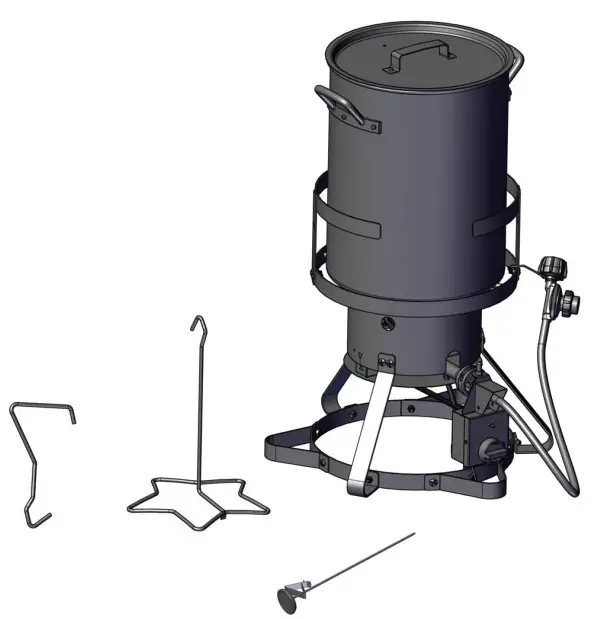
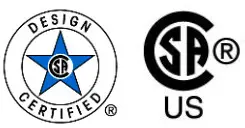
- This instruction manual contains important information necessary for the proper assembly and safe use of the appliance.
- Read and follow all warnings and instructions before assembling and using the appliance.
- Follow all warnings and instructions when using the appliance.
- Keep this manual for future reference.
Safety Instructions
 DANGER
DANGER
If you smell gas:
- Shut off gas to the appliance.
- Extinguish any open flame.
- If odor continues, keep away from the appliance and immediately call your gas supplier or your fire department.
Failure to follow these instructions could result in fire, explosion or burn hazard, which could cause property damage, personal injury or death.
 DANGER
DANGER
a) Do not store a spare LP-gas cylinder under or near this appliance.
b) NEVER fill the cylinder beyond 80 percent full.
c) If the information in “a” and “b” is not followed exactly, a fire or explosion causing death or serious injury may occur.
DANGER
- Never operate this appliance unattended.
- Never operate this appliance within 3.05 m / 10 ft. of any structure, combustible material or gas cylinder.
- Never operate this appliance within 7.62 m / 25 ft. of any flammable liquid.
- Heated liquids remain at scalding temperatures long after the cooking process.
Never touch the cooking appliance until liquids have cooled to 46 ºC / 115 ºF or less. - If a fire should occur, keep away from the appliance and immediately call your fire department. Do not attempt to extinguish an oil or grease fire with water.
Failure to follow these instructions could result in fire, explosion or burn hazard, which could cause property damage, personal injury, or death.
THIS GAS APPLIANCE IS DESIGNED FOR OUTDOOR USE ONLY
Please read the following instructions carefully before attempting to assemble, operate or install the product. Failure to follow these instructions may result in serious bodily injury and/or property damage. If you have questions regarding the product, please call our Customer Service Department at U.S.A:1-800-913-8999, 8 a.m. – 5 p.m., PST, Monday-Friday. Make sure you have the serial number available.
LP gas supply cylinder to be used must be constructed and marked in accordance with the specifications for LP gas cylinders of the U.S. Department of Transportation (DOT) or the National Standard of Canada, CANB339, Cylinders, Spheres and Tubes for the Transportation of Dangerous Goods.
CALIFORNIA RESIDENTS ONLY – WARNING: This product and the fuels used to operate this product (liquid propane), and the products of combustion of such fuels, can expose you to chemicals including benzene, which is known to the State of California to cause cancer and reproductive harm.
For more information go to: www.P65Warnings.ca.gov.
- The installation must conform with local codes or, in the absence of local codes, with the National Fuel Gas Codes, the National Fuel Gas Code, ANSI Z223.1/NFPA 54, Storage and Handling of Liquefied Petroleum Gases, ANSI/NFPA 58, or the Standard for Recreational Vehicles, ANSI A119.2/NFPA 1192, and the Recreational Vehicle Code, CSA Z240 RV, as applicable.
- This appliance shall not be used on or under any apartment or condominium balcony or deck.
- This appliance shall be used only outdoors, and shall not be used in a building, garage or any other enclosed area.
- This appliance is not intended to be installed in or on a boat and/or recreational vehicles.
- Keep appliance at least 10 ft (3m) from any combustible materials and wall. Keep at least 10 ft (3m) from such materials on the sides and back of the appliance, and the appliance must not be located under overhead unprotected combustible construction. Never use under balconies made of wood or ANY overhead construction.
- Keep the fuel supply hose away from any heated surfaces.
- This appliance is NOT intended for commercial use.
- The use of alcohol, prescription or non-prescription drugs might impair the consumer’s ability to properly assemble or safely operate the appliance.
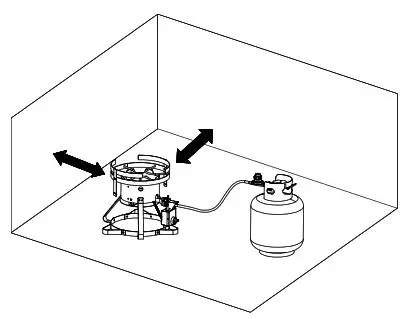
- When cooking with oil or grease, have a type BC or ABC fire extinguisher readily available. In the event of an oil or grease fire DO NOT attempt to extinguish with water. Immediately call the FIRE DEPARTMENT. A Type BC or ABC fire extinguisher may, in some circumstances contain the fire.
- In the event of rain, snow, hail, sleet or other forms of precipitation while cooking with oil or grease, cover the cooking vessel immediately and turn off the appliance burners and gas supply. DO NOT attempt to move the appliance or cooking vessel.
- When cooking, the appliance fryer/boiler MUST BE ON A LEVEL, STABLE NONCOMBUSTIBLE SURFACE in an area clear of combustible material. An asphalt surface (blacktop) is not acceptable for this purpose.
- DO NOT leave the appliance unattended. Keep children and pets away from the appliance at all times.
- Do not place an empty cooking vessel on the appliance while in operation. Use caution when placing anything in the cooking vessel while the appliance is in operation.
- Do not move the appliance when in use. Allow the cooking vessel to cool to 115 ºF (45 ºC) before moving or storing.
- For outdoor use only. If stored indoors, detach and leave cylinder outdoors.
- This appliance is not intended for and should never be used as a heater.
- When cooking with oil or grease, the thermometer provided MUST be used. Follow instructions in this manual for proper installation and use of the thermometer. If the thermometer supplied with this fryer/boiler has been lost or damaged, a replacement thermometer must be one specified by the appliance manufacturer.
- This appliance will be HOT during and after use. Use insulated oven mitts or gloves for protection from hot surfaces or splatter from cooking liquids.
- If the temperature exceeds 400 ºF (200 ºC) or if oil begins to smoke, immediately turn the burner or gas supply OFF and wait for the temperature to decrease to less than 350 ºF(175 ºC) before relighting the burner according to the manufacturer’s instructions. If there is a lid (cover), do not remove the lid.
- It is recommended that the cooking vessel not exceed 30QT & 12” diameter. A BIGGER VESSEL MAY RESULT IN TIPPING.
- Never use a cooking vessel larger than the capacity and diameter recommended by the manufacturer.
- Never overfill the cooking vessel with oil, grease or water than specified by vessel manufacturer instruction. If the vessel doesn’t indicate the maximum fill line, please refer to the following instructions for determining the maximum fill level. Determining the maximum fill level when using a vessel without a maximum line: (1) Place the food product in the basket. (2) Place the food product and holder into the empty vessel. (3) Fill the vessel with water just until the food product is completely submerged. There must be a minimum of 3 inches (8 cm) between the water level and top of the vessel. (4) Remove the food product from the vessel and either mark the water level on the side of the vessel or measure the amount of water in the vessel. (5) Remove the water and completely dry the vessel and the food product. (6) This is the amount of cooking oil the vessel is to be filled with to cook the food product.
- Introduction of water or ice from any source into the oil/grease may cause overflow and severe burns from hot oil and water splatter. When frying with oil/grease, all food products MUST be completely THAWED and towel DRIED before being immersed in the fryer.
- Avoid bumping into or impacting the appliance to prevent spillage or splashing of the hot cooking liquid.
- Never drop food or accessories into hot cooking liquid. Lower food and accessories slowly into the cooking liquid in order to prevent splashing or overflow. When removing food from the appliance care must be taken to avoid burns from hot cooking liquids.
NATURAL HAZARD • SPIDERS
FACT: Sometimes spiders and other small insects climb into the burner tube. The spiders spin webs, build nests and lay eggs. The webs or nests can be very small, but they are very strong and can block the flow of gas. Clean burner prior to use after storing or after a period of one month not being used.

The Fuel System:
Gas appliances are used safely by millions of people when following simple safety precautions.
The items in the fuel system are designed for operation with this appliance. They must not be replaced with any other brand. (See parts list for replacement items.)
GAS BURNER: The gas burner is constructed of stainless steel and should not require maintenance other than inspection for insects/nests inside the air intake slots.
LP GAS REGULATOR CAUTION:
The gas pressure regulator provided with this appliance must be used. This regulator is equipped with the required orifice and is set for the required outlet pressure for this appliance. This combination of orifice size and pressure regulation specifications provides the cooking performance intended by the appliance.
Substitution of regulators by any other device or any other manufacturer is dangerous and could result in serious injury.
PROPANE FUEL: Warning – propane is a flammable gas. Improper handling may result in an explosion and/or fire and serious accidents or injuries. Your appliance is designed to operate with propane (LP) gas only and is equipped with the proper orifice for propane gas.
Caution: Do not connect this appliance with any gas supply other than propane. Propane gas is heavier than air and settles in lower areas. Make certain adequate ventilation is available when using your appliance. The gas cylinder may be stored outside in a well-ventilated area out of the reach of children when the appliance is not in use.
The LP gas cylinder shall be used only outdoors in a well-ventilated space and not in a building, garage, or any other enclosed area. The appliance may be stored indoors if the LP gas cylinder is removed and stored outdoors. The LP gas cylinder (not included) is threaded for connection directly to the gas regulator supplied with this appliance. Care should be taken when threading the cylinder to the regulator to engage threads correctly to achieve the proper and intended connection. When disconnecting or connecting the gas cylinder, be careful that the regulator does not strike the appliance, the ground, or any other surfaces. Replace the protective cap over the threaded cylinder connection when removed from the appliance. If any difficulty occurs when connecting or disconnecting the cylinder to the regulator assembly, contact your local gas supplier for assistance.
When reconnecting the LP gas cylinder to the regulator, be sure to hand-tighten until snug. This connection should be inspected for damage and leak-tested after each reconnection.
To-Do a Leak Test, make a soap solution of one part liquid detergent and one part water. You will need a spray bottle, brush, or rag to apply the solution to the fitting. Bubbles indicate leaks.
Check all gas supply fittings for leaks before each use. Do not use the appliance until all connections have been checked and do not leak.
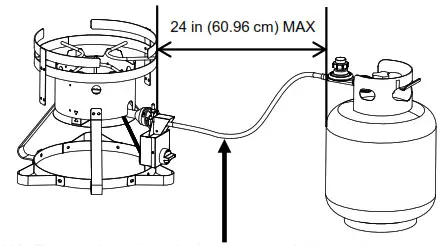
WARNING: The gas hose is a tripping hazard, which can tip over the appliance and propane tank, causing serious personal injuries or property damage.
Tools Needed
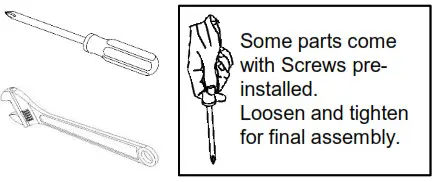
Hardware package list
| Truss Head Screw 1/4-20 x 1/2” |
Hex Nut 1/4-20 |
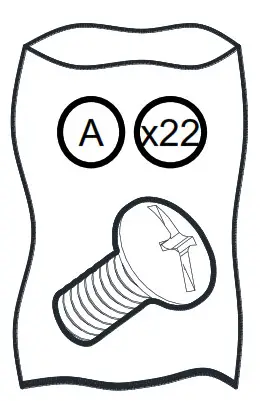 |
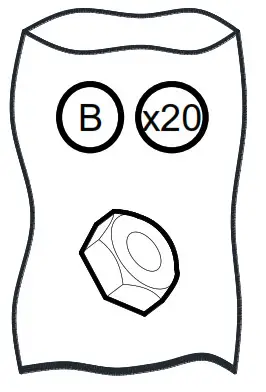 |
Package Parts List

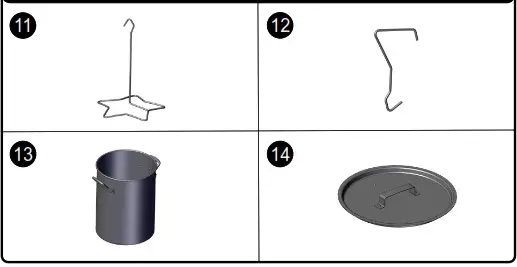
Assembly Steps
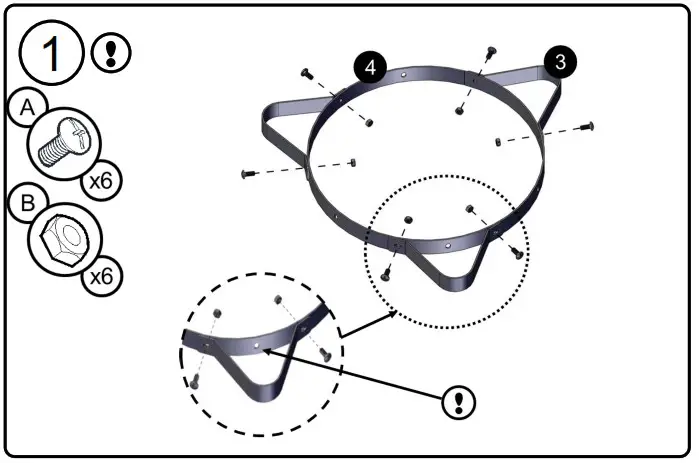
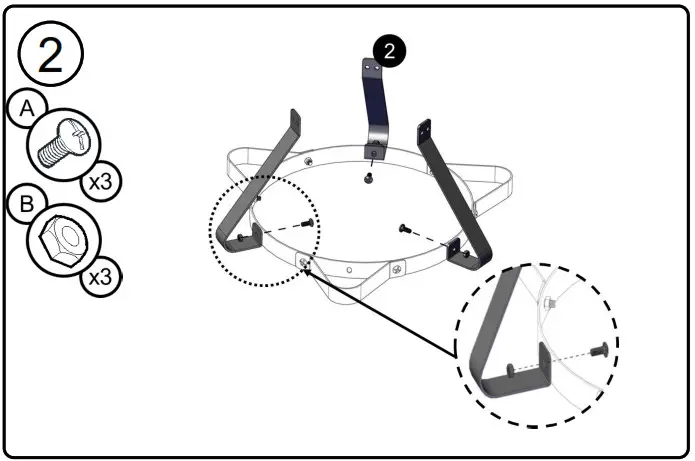
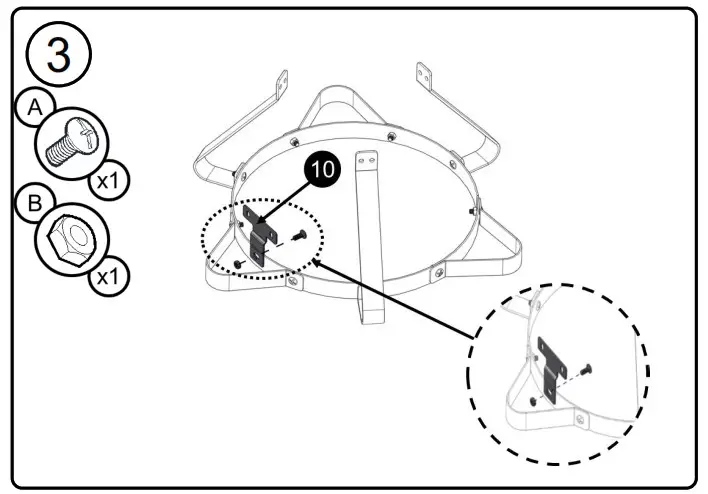
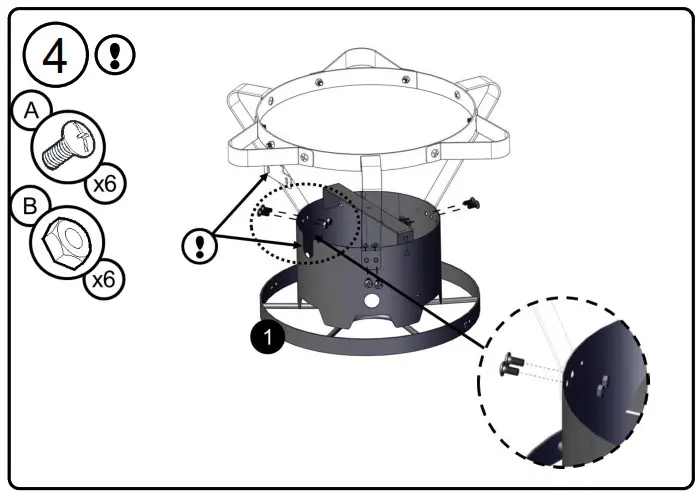
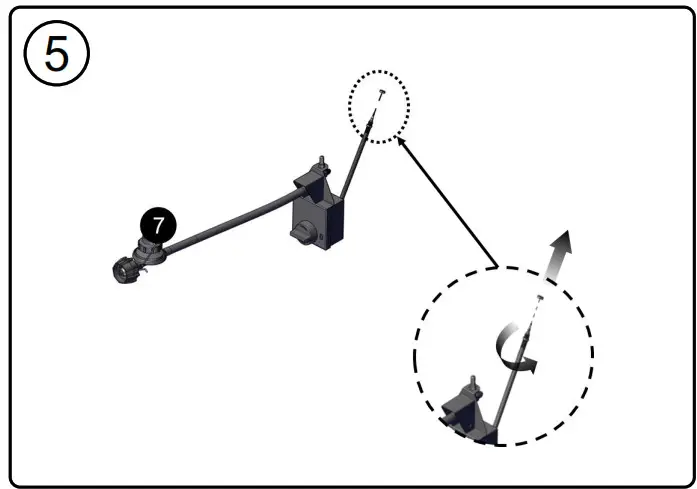
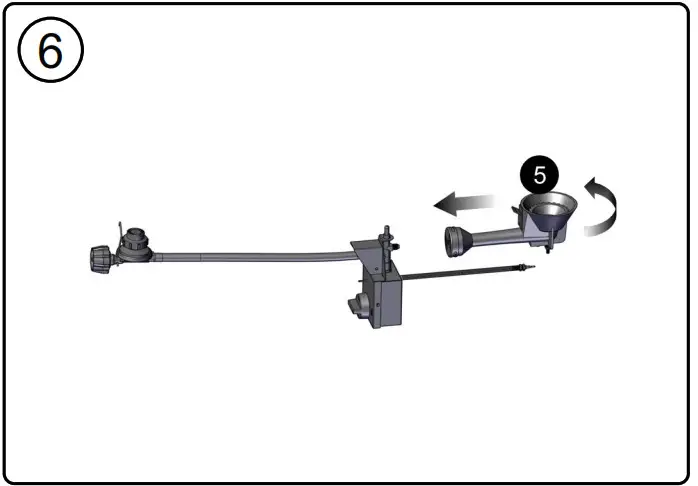
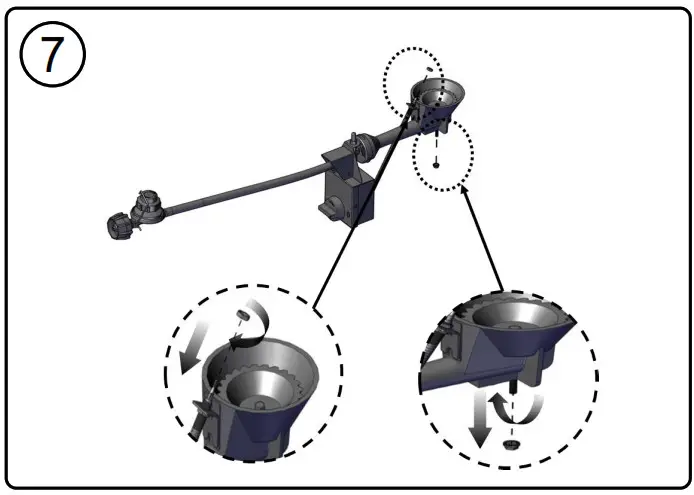
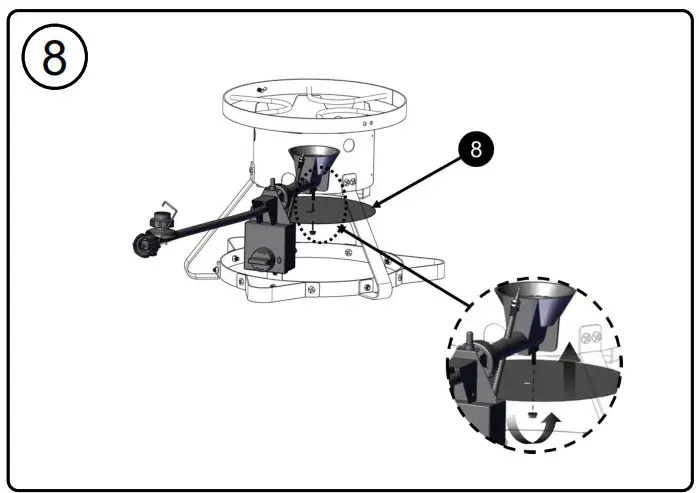
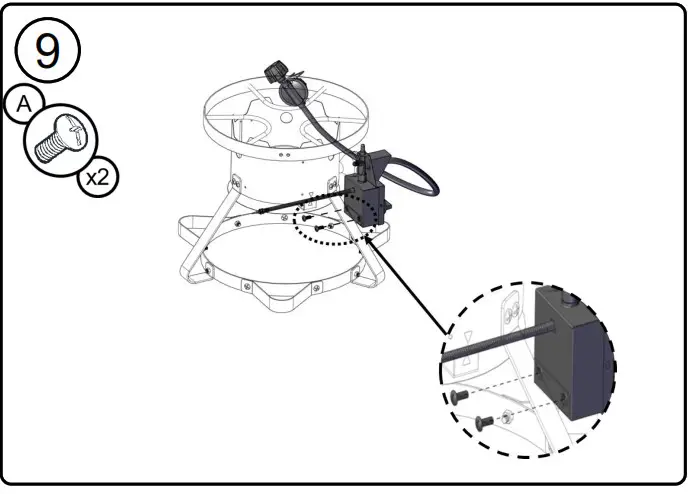
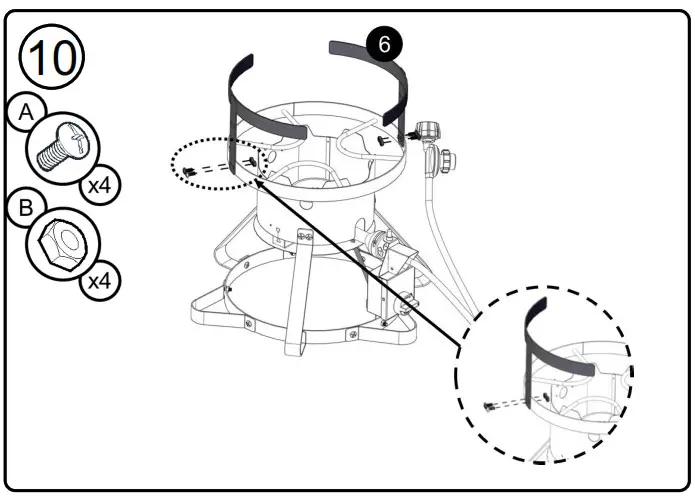
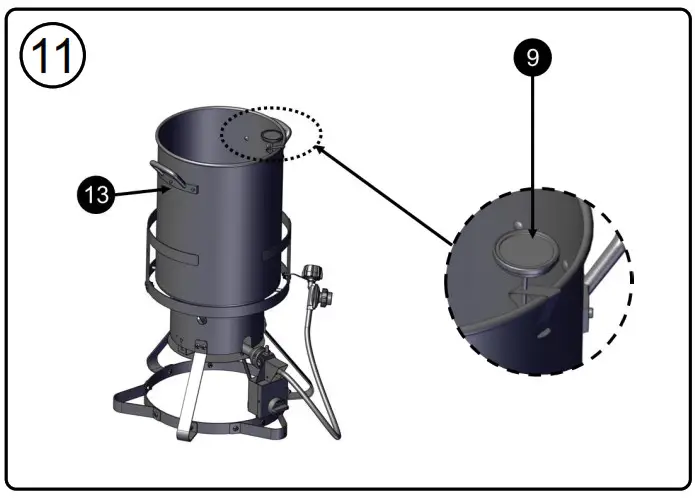
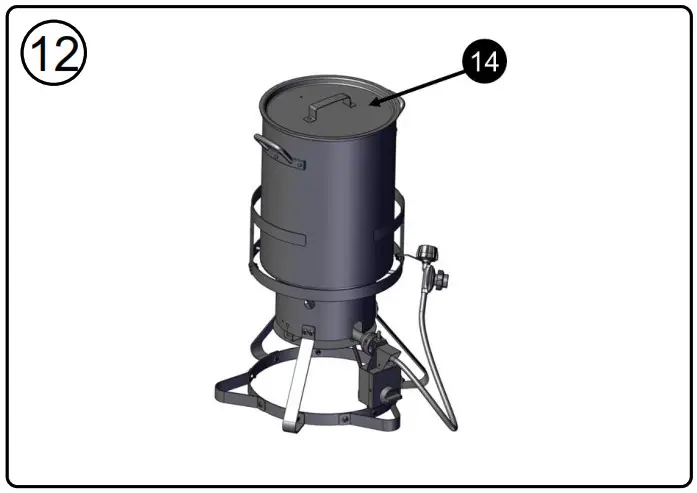
Operating instructions
GAS HOOK-UP
Only the pressure regulator and hose assembly supplied with the appliance should be used. Any replacement pressure regulator and hose assembly must be specified by the appliance manufacturer. This grill is configured for liquid propane. Do not use a natural gas supply.
Total gas consumption (per hour): 38,000 BTU
The installation of this appliance must conform with local codes or, in the absence of local codes, with either the National Fuel Gas Code, ANSI Z223.1/NFPA 54, National Gas Propane Installation Code, CSA B149.1, or Propane Storage and Handling Code.
LIQUID PROPANE CYLINDER REQUIREMENTS
The LP tank used with your appliance must meet the following requirements:
- Purchase LP tanks only with these required measurements: 12”(30.5cm)(diameter) x 18”(45.7cm)(tall) with 20lb. (9kg) capacity maximum.
- The LP-gas supply cylinder to be used must be constructed and marked in accordance with the specifications for LP-gas cylinders of the US Department of Transportation (DOT) or the National Standard of Canada, CAN/CSA-B339, Cylinders, Spheres and Tubes for the Transportation of Dangerous Goods.
CAUTION: Use cylinders that are marked “Propane Fuel” only.
LP TANK VALVE REQUIREMENTS
LP tank valve must have:
- Type 1 outlet compatible with regulator or appliance.
- Safety relief valve.
- UL listed Overfill Protection Device (OPD). This OPD safety feature is identified by a unique triangular handwheel. Use only tanks equipped with this type of valve.
- LP tank must be arranged for vapor withdrawal and include a collar to protect LP tank valve.
CONNECTING THE LIQUID PROPANE CYLINDER
To connect the liquid propane gas supply cylinder:
The cylinder valve should be in the “OFF” position. If not, turn the valve clockwise until it stops.
Make sure the cylinder valve has the proper type-1 external male thread connections per ANSI Z21.81.
Make sure the burner valves are in the “OFF” position.
Inspect the valve connections, port and regulator assembly. Remove debris and inspect the hose for damage.
When connecting the regulator assembly to the valve, use your hand to tighten the nut clockwise until it stops. Use of a wrench could damage the quick-coupling nut and result in a hazardous situation
Open the cylinder valve fully by turning the valve counterclockwise.
Before lighting the grill, use a soap and water solution to check all the connections for leaks.
If a leak is found, turn the cylinder valve “OFF” and do not use the grill until a local liquid propane dealer can make repairs.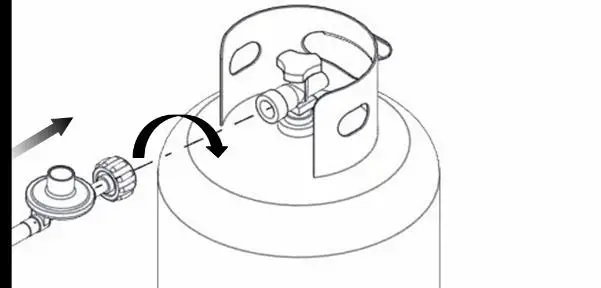
 Never attempt to use damaged or obstructed equipment. See your local liquid propane dealer for repair.
Never attempt to use damaged or obstructed equipment. See your local liquid propane dealer for repair.
DISCONNECTING THE LIQUID PROPANE CYLINDER
- Turn the control knob of the regulator to the OFF position.
- Turn LP tank OFF by turning hand wheel clockwise to a full stop.
- Turn the coupling nut counterclockwise to loosen the connector. Loose by hand only – do not use tools.
- When disconnected, the regulator should be hung on the hook attached to the appliance.
LEAK TESTING
GENERAL
Although gas connections on the appliance are leak-tested prior to shipment, a complete leak test must be performed at the installation site. Before each use, check all gas connections for leaks using the procedures listed below.
If the smell of gas is detected at any time, you should immediately check the entire system for leaks.
BEFORE TESTING
Make sure all packing materials have been removed from the grill, including any burner tie-down straps.
WARNING
Check all gas supply fittings for leaks before each use. Do not use the appliance until all connections have been checked and do not leak. Do not smoke while leak-testing. Never leak-test with an open flame.
Make a solution of one part liquid detergent and one part water. You will need a spray bottle, brush, or rag to apply the solution to the fittings. For the initial leak test, make sure the liquid propane cylinder is full.
TO TEST
- Turn the burner valve off.
- Apply the soap solution to all gas fittings. Soap bubbles will appear where a leak is present.
- If a leak is present, immediately turn the gas supply “OFF” and tighten leaky fittings.
- Turn the gas back “ON” and recheck.
- Should the gas continue to leak from any of the fittings, turn the gas supply “OFF” and contact our Customer Service Department at U.S.A:1-800-913-8999, 8 a.m. – 5 p.m., PST, Monday-Friday.
- If there is evidence of excessive abrasion or wear, it must be replaced prior to the outdoor cooking gas appliance being put into operation.
- Only those parts recommended by the manufacturer should be used on the grill. Substitutions will void the warranty.
 WARNING
WARNING
Do not store appliances indoors unless the cylinder is disconnected. Do not store cylinders in a building, garage, or any other enclosed area, and keep out of reach of children at all times.
HOSE ASSEMBLY AND REGULATOR CHECK
Cleaning and inspection of the pressure regulator and hose assembly prior to use. If there is evidence of abrasion, wear, cuts or leaks, the hose assembly must be replaced prior to the appliance being put into operation. The replacement hose assembly shall be specified by the manufacturer.
USING YOUR THEROMOETER
The thermometer must be checked before each use. To do this, insert the thermometer into a pot of boiling water and ensure that it registers approximately 212 ± 20 ºF (100 ± 10 ºC). If it does not function properly, obtain a replacement thermometer specified by the manufacturer before using the appliance.
The thermometer should be positioned so that at least 2.75” of the thermometer tip is always submerged in oil; repositioning as needed during use. The thermometer must be used until the burner is turned off.
LIGHTING THE APPLIANCE
- Read instructions before lighting.
- Turn the regulator control valve to the OFF position.
- Turn the timer knob clockwise as far as it will go.
- Slowly open the cylinder valve.
- Have a standard match, fireplace match or long-nosed propane lighter lit and place it over the burner.
- Press and hold the safety valve button while slowly opening the regulator control valve, keeping face and body away from the top of the cooker stand.
- After the burner is lit, continue to hold down the safety valve for 10-15 seconds. If the safety valve is not held down for 10-15 seconds, the flame will not stay lit.
- If ignition does not occur in 5 seconds, turn the burner control(s) off, wait 5 minutes, and repeat the lighting procedure.
- If the appliance fails to ignite after the second attempt, see the troubleshooting section of the manual and/or call our Customer Service Department at U.S.A: 1-800-913-8999.
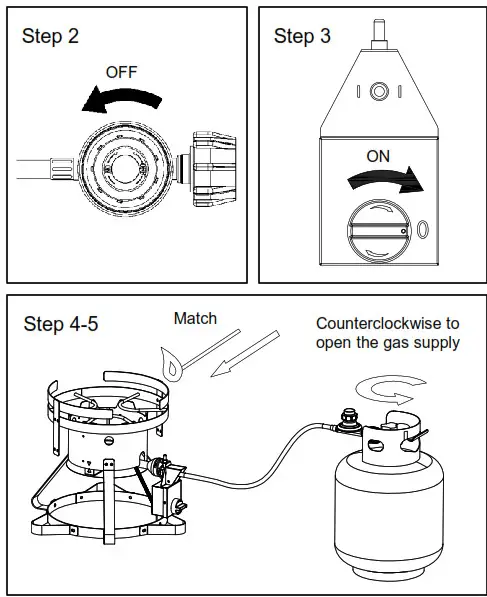
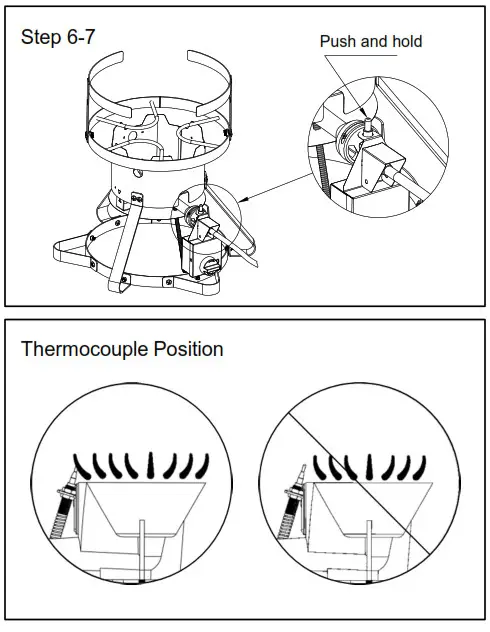
NOTE: The timer cycle is set at about 15 minutes. If the timer is not reset before the 15 minutes are up, the burner will shut off automatically. If this happens, just re-light according to the instructions above and continue to cook.
THERMOCOUPLE POSITION
If the burner will not light, check the position of the thermocouple. The nut that holds the thermocouple should be installed correctly and locked in place. The flame will not stay lit unless it has full contact with the thermocouple.
TURNING LP COOKER OFF
Turn all knobs to OFF position, turn LP tank OFF by turning hand-wheel clockwise to a full stop.
CAUTION: Never allow oil or grease to get hotter than 400 ºF or 200 ºC. If the temperature exceeds 400 ºF (200 ºC) or if oil begins to smoke, immediately turn the burner or gas supply OFF and wait for the temperature to decrease to less than 350 ºF(175 ºC) before relighting the burner according to the manufacturer’s instructions. If there is a lid (cover), do not remove the lid.
PREPARING THE TURKEY
- Thaw the turkey COMPLETELY before frying. Do not attempt to fry a frozen or partially frozen turkey. USDA recommends thawing the turkey in the refrigerator for 24 hours per 4-5 pounds.
- Remove any thermometer buttons, giblet packs, and leg holders from the turkey. Insert the star turkey lifter into the cavity of the turkey so that the legs are facing upward.
- If using a vessel without a maximum fill line, or to determine the proper amount of oil to fry your food item, follow the instructions below:
1. Place the turkey on the star lifter and lower it into the cooking vessel.
2. Fill the vessel with just enough water to cover the turkey. The water level must be at least 3 in (8 cm) below the top edge of the vessel.
3. Remove the turkey and either mark the water level on the side of the vessel or measure the amount of water. This is the amount of peanut oil to use for frying the turkey.
4. Remove the water and dry the turkey and vessel. - If using a marinade on the turkey, inject it into the thicker areas like the breasts and thighs. – Use the marinade injector as instructed on its packaging; or, in the absence of instructions, fill the injector with marinade and insert the needle into the turkey. Then, push the plunger while slowly withdrawing the needle to prevent creating large pockets of marinade.
- Pat dry the surfaces of the turkey completely to reduce oil splattering. Once dry, seasonings can be applied to the skin.
COOKING THE TURKEY
- Check the regulator hose connections and conduct a leak test prior to use.
- Make sure that there is proper clearance on all sides of the unit, that the propane tank is not too close to the appliance, and that the vessel is centered on the burner.
- Fill the cooking vessel with the amount of peanut oil determined above in the “turkey preparation” section.
– Do not place an empty cooking vessel on the appliance once the burner is lit as the cooking vessel can melt. - Attach the thermometer to the side of the cooking vessel making sure that at least 2.75” of the thermometer tip is submerged in oil.
- Light the burner as described on the previous page and heat the oil to 325 ºF (162 ºC). Never leave the fryer unattended during use.
- Once the oil reaches 325 ºF (162 ºC), the oil is at the right temperature to fry. If during the frying process the oil temperature reaches 400 ºF (204 ºC) or if the oil begins to smoke, turn the burner off immediately.
- Wearing long, insulated, flame retardant gloves, use the lift hook to slowly lower the turkey into the cooking vessel.
- Adjust the burner as necessary to maintain the oil temperature at 325 ºF (162 ºC) throughout the frying process. Do not leave the fryer unattended.
- Cook until the turkey is golden brown (approximately 3.5 minutes per pound).
- Carefully remove the turkey using the lift hook and place it on paper towels in an aluminum pan.
- Check the internal temperature of the turkey using a meat thermometer. The internal temperature should reach 180 ºF (82 ºC).
- Remove the star lifter from the turkey and allow the turkey to sit for 15 minutes before slicing so that the juices can settle back into the meat.
Care and Maintenance
There is very little care and maintenance needed. The appliance is designed and made of materials that will last many years with normal use. Following these instructions will improve the longevity of the grill and quality of cooking. To ensure safe operation of your grill, the area of cooking should always be kept free of combustible materials of any type, such as gasoline or other flammable vapors or liquids.
Outside appliance Parts – Can be cleaned easily with warm soapy water.
Burner – Extreme care should be taken when removing a burner. It must be correctly centered on the orifice before any attempt is made to relight the grill. The frequency of cleaning will depend on how often you use the grill.
Failure to properly place the burner back into position could cause a fire to occur, thereby damaging the grill and making it unsafe to operate.
Before cleaning, make sure the gas supply and regulator knob are in the “OFF” position and the burners have cooled.
To remove the main burners for cleaning:
- Remove the regulator assembly from the burner end.
- Locate the burner screw inside the firebox.
- Remove the screw and slide the burner out of the firebox.
To clean the grill burner:
- Clean the exterior of the burner with a wire brush. Use a metal scraper for stubborn stains or debris.
- Clear clogged ports with a straightened paper clip. Never use a wooden toothpick as it may break off and clog the port.
- Check and clean burners/venturi tubes for insects and insect nests. A clogged tube can lead to flashbacks.
To reinstall the main burners:
- Insert the burner into the firebox.
- Align the burner screw hole with the firebox hole, insert the screw, and tighten.
- Reinstall the regulator assembly onto the burner end.
General – This appliance, like all equipment, will look better and last longer if kept out of the weather when not in use.
Caution: Do not store propane cylinders in enclosed areas. When using a cover or moving the appliance, always wait until the appliance has cooled for at least 30 minutes.
– Do not obstruct the flow of combustion and ventilation air.
– A clogged tube can lead to a fire beneath the appliance.
This unit must be kept in an area free from combustible materials, gasoline and other flammable vapors and liquids.
Make sure all openings into the appliance body are free of blockages or debris and there are no objects or materials blocking the flow of combustion or ventilation.
Check burner air inlet openings (behind the inlet guard on the right end of the grill body) for insect nests or blockages. Make sure the slots in the burner tube are clear.
When the appliance is not in use, turn the control knob to the “OFF” position and remove the propane cylinder from the regulator. Remove the regulator from the burner.
For outdoor use only, if stored indoors, detach propane cylinder and store outdoors. Propane cylinders must be stored out of reach of children.
THIS COOKING APPLIANCE IS FOR OUTDOOR USE ONLY AND SHALL NOT BE USED IN A BUILDING, GARAGE OR ANY OTHER ENCLOSED AREA.
MOVING INSTRUCTIONS
- Caution: Never move the appliance with burner lit.
- Make sure the control knob is in the “OFF” position. Disconnect the propane cylinder from the regulator.
- Be sure the appliance has completely cooled for at least 30 minutes.
 WARNING
WARNING
Spiders and insects can nest inside the burners of the grill and disrupt gas flow. This very dangerous condition could cause a fire behind the valve panel, thereby damaging the grill and making it unsafe for operation. Inspect the grill at least twice a year.
When to Look for Spiders
You should inspect the burners at least twice a year or immediately after any of the following conditions occur:
- Gas can be smelled in conjunction with burner flames appearing yellow.
- The grill does not reach temperature.
- The grill heats unevenly.
- The burners make popping noises.
Troubleshooting
| Problem | What To Do |
| The appliance will not light. | • Check to see if the liquid propane cylinder is empty. • Check burner ports for any blockage. Use a soft wire brush to clear plugged ports. • Check the gas orifice on the burner for an obstruction. If the orifice is blocked, clean with a needle or thin wire. NEVER USE A WOODEN TOOTHPICK. • Check to see if the thermocouple is assembled correctly. • Check that the timer’s knob is rotated to the correct position. • Make sure that you are pressing the valve switch for 10-15 seconds. |
| The burner flame is yellow or orange in conjunction with the gas odor. | • Check for spiders and insects. • Call our Customer Service Department at U.S.A:1-800-913-8999, 8 a.m. – 5 p.m., PST, Monday-Friday |
| Low heat with the control knob on the “HIGH” setting. | • Make sure the grill area is clear of dust. • Make sure the burner and orifice are clean. • Check for spiders and insects. • Is there an adequate gas supply available? • Is the grill being preheated for 15 minutes? |
If the grill is not working properly, perform each check of the following list before contacting customer service.
Exploded View
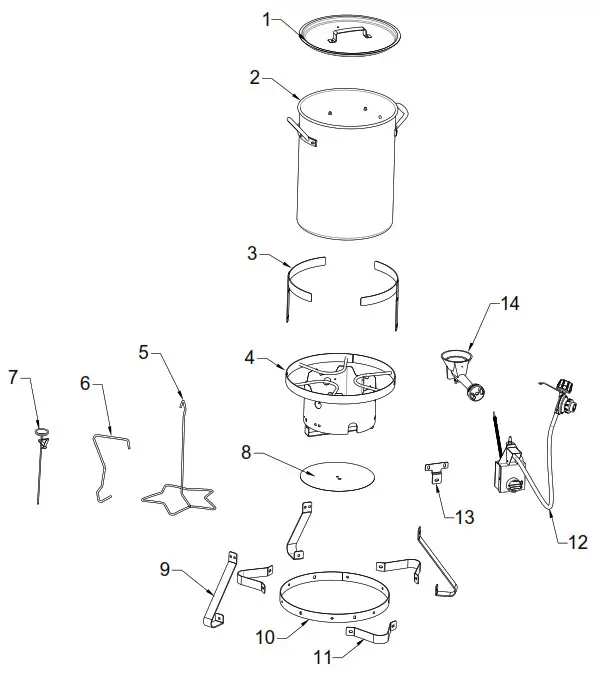
 Questions, problems, missing parts? Before returning to your retailer, call our Customer Service Department at U.S.A:1-800-913-8999, 8 a.m. – 5 p.m., PST, Monday-Friday.
Questions, problems, missing parts? Before returning to your retailer, call our Customer Service Department at U.S.A:1-800-913-8999, 8 a.m. – 5 p.m., PST, Monday-Friday.
Replacement Parts
| No. | Part (Description) | Warranty coverage | Qty |
| 1 | Pot lid assembly | 1 | 1 |
| 2 | Pot assembly | 1 | 1 |
| 3 | Pot support arms | 1 | 2 |
| 4 | Cart assembly | 1 | 1 |
| 5 | Star turkey lifter | 1 | 1 |
| 6 | Lift hook | 1 | 1 |
| 7 | 12” Deep fry thermometer | 1 | 1 |
| 8 | Bottom heat shield | 1 | 1 |
| 9 | Arc-shaped support leg | 1 | 3 |
| 10 | Bottom ring | 1 | 1 |
| 11 | V-shaped support leg | 1 | 3 |
| 12 | Regulator and safety valve assembly | 1 | 1 |
| 13 | T-shaped panel | 1 | 1 |
| 14 | Burner assembly | 1 | 1 |
Limited Warranty
Nexgrill warrants to the original consumer purchaser only that this product (Model #840-0005) shall be free from defects in workmanship and materials after correct assembly and under normal and reasonable home use for the periods indicated below beginning on the date of purchase. The manufacturer reserves the right to require photographic evidence of damage, or the return of defective parts, postage and or freight pre-paid by the consumer, for review and examination.
- MAIN BURNER: 1-year limited warranty against perforation.
- ALL OTHER PARTS: 1-Year LIMITED warranty (Includes, but is not limited to, valves, frame, housing, cart, control panel, igniter, regulator, hoses) *Does not cover chipping, scratching, cracking surface corrosion, scratches or rust.
Upon consumer supplying proof of purchase as provided herein, the Manufacturer will repair or replace the parts that are proven
defective during the applicable warranty period. Parts required to complete such repair or replacement shall be free of charge to you except for shipping costs, as long as the purchaser is within the warranty period from the original date of purchase. The original consumer-purchaser will be responsible for all shipping charges of parts replaced under the terms of this limited warranty. This limited warranty is applicable in the United States and Canada, is only available to the original owner of the product and is not transferable. The manufacturer requires reasonable proof of your date of purchase. Therefore, you should retain your sales receipt and/or invoice. If the unit was received as a gift, please ask the gift-giver to send in the receipt on your behalf, to the below address.
Defective or missing parts subject to this limited warranty will not be replaced without registration or proof of purchase. This limited warranty applies to the functionality of the product ONLY and does not cover cosmetic issues such as scratches, dents, corrosions or discoloring by heat, abrasive and chemical cleaners or any tools used in the assembly or installation of the appliance, surface rust, or the discoloration of stainless-steel surfaces. Surface rust, corrosion, or powder paint chipping on metal parts that does not affect the structural integrity of the product is not considered a defect in workmanship or material and is not covered by this warranty. This limited warranty will not reimburse you for the cost of any inconvenience, food, personal injury or property damage. If an original replacement part is not available, a comparable replacement part will be sent. You will be responsible for all shipping charges of parts replaced under the terms of this limited warranty.
ITEMS MANUFACTURER WILL NOT PAY FOR:
- Service calls to your home.
- Repairs when your product is used for other than normal, single-family household or residential use.
- Damage resulting from accident, alteration, misuse, lack of maintenance/cleaning, abuse, fire, flood, acts of God, improper
installation, and installation not in accordance with electrical or plumbing codes or use of products not approved by the manufacturer. - Any food loss due to product failures.
- Replacement parts or repair labor costs for units operated outside the United States or Canada.
- Pickup and delivery of your product.
- Postage fees or photo processing fees for photos sent in as documentation.
- Repairs to parts or systems resulting from unauthorized modifications made to the product.
- The removal and/or reinstallation of your product.
- Shipping cost, standard or expedited, for warranty/non-warranty and replacement parts.
DISCLAIMER OF IMPLIED WARRANTIES; LlMlTATlON OF REMEDIES
Repair or replacement of defective parts is your exclusive remedy under the terms of this limited warranty. The manufacturer will not be responsible for any consequential or incidental damages arising from the breach of either this limited warranty or any applicable implied warranty, or for failure or damage resulting from acts of God, improper care and maintenance, grease fire, accident, alteration, replacement of parts by anyone other than Manufacturer, misuse, transportation, commercial use, abuse, hostile environments (inclement weather, acts of nature, animal tampering), improper installation or installation not in accordance with local codes or printed manufacturer instructions.
THlS LIMITED WARRANTY IS THE SOLE EXPRESS WARRANTY GIVEN BY THE MANUFACTURER. NO PRODUCT PERFORMANCE SPECIFICATION OR DESCRIPTION WHEREVER APPEARING IS WARRANTED BY MANUFACTURER EXCEPT TO THE EXTENT SET FORTH IN THlS LIMITED WARRANTY. ANY IMPLIED WARRANTY PROTECTION ARISING UNDER THE LAWS OF ANY STATE OR PROVINCE, INCLUDING IMPLIED WARRANTY OF MERCHANTABILITY OR FITNESS FOR A PARTICULAR PURPOSE OR USE, IS HEREBY LIMITED IN DURATION TO THE DURATION OF THlS LIMITED WARRANTY.
Neither dealers nor the retail establishment selling this product has any authority to make any additional warranties or to promise
remedies in addition to or inconsistent with those stated above. The manufacturer’s maximum liability, in any event, shall not exceed the documented purchase price of the product paid by the original consumer. This warranty only applies to units purchased from an authorized retailer and or re-seller. NOTE: Some states and provinces do not allow an exclusion or limitation of incidental or consequential damages, so some of the above limitations or exclusions may not apply to you; this limited warranty gives you specific legal rights as set for herein. You may also have other rights, which vary from province to province.
If you wish to obtain performance of any obligation under this limited warranty, you should write to:
Nexgrill Customer Relations
14050 Laurelwood Place,
Chino, CA 91710
All consumer returns, parts orders, general questions, and troubleshooting assistance can be acquired by calling our Customer
Service Department at U.S.A:1-800-913-8999, 8 a.m. – 5 p.m., PST, Monday-Friday.

© 2020 NEXGRILL INDUSTRIES, INC.
CHINO, CA. 91710
WWW.NEXGRILL.COM
1-800-913-8999
Fortress™ 2 Burner Cast Aluminum Table Top Gas Grill Owner’s Manual
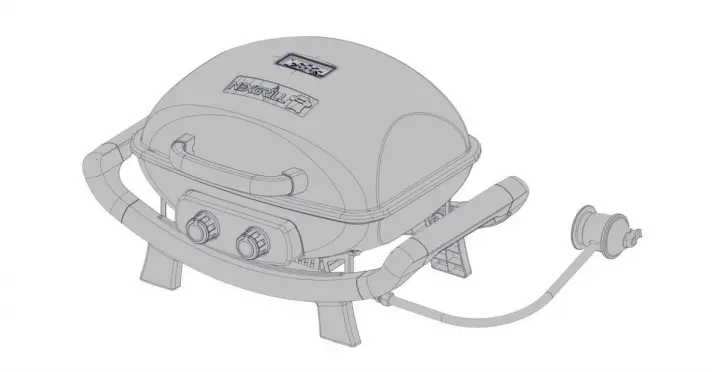
FOR OUTDOOR USE ONLY. NOT FOR COMMERCIAL USE.
Model: 820-0062D

- This instruction manual contains important information necessary for the proper assembly and safe use of the appliance.
- Read and follow all warnings and instructions before assembling and using the appliance.
- Follow all warnings and instructions when using the appliance.
- Keep this manual for future reference.
IMPORTANT SAFETY INFORMATION
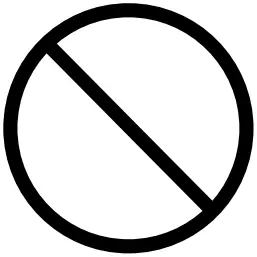
DANGER: If you smell gas:
- Shut off gas to the appliance.
- Extinguish any open flame.
- Open lid.
- If odor continues, keep away from the appliance and immediately call your gas supplier or local fire department.
DANGER
- Never operate this appliance unattended.
- Never operate this appliance within 3.05 m (10 ft) of any structure, combustible material or other gas cylinder.
- Never operate this appliance within 7.62 m (25 ft) of any flammable liquid.
- This appliance is not intended for and should never be used as a heater.
- If a fire should occur, keep away from the appliance and immediately call your fire department. Do not attempt to extinguish an oil or grease fire with water.
FAILURE TO FOLLOW THESE INSTRUCTIONS COULD RESULT IN FIRE, EXPLOSION OR BURN HAZARD, WHICH COULD CAUSE PROPERTY DAMAGE, PERSONAL INJURY OR DEATH.
Read the following instructions carefully before attempting to assemble, operate or install the product. Failure to follow these instructions may result in serious bodily injury and/or property damage. If you have questions regarding the product, please call our customer service department at+4562206336. 8 a.m.-5 p.m. PST Monday-Friday. You can also reach us by email at: [email protected]

- Tabletop grill is for outdoor use only. Grill should be operated in a well-ventilated space. Never operate in an enclosed space, garage or building. Your grill is not intended to be installed in or on recreational vehicles and/or boats.
- Heated liquids remain at scalding temperatures long after the cooking process. Do not touch the cooking appliance until liquids have cooled to 46.11 °C (115 °F) or lower.
- Do not install or use grill within 91.44 cm (36 in) of combustible materials from back and sides of grill. Grill shall not be located under overhead surfaces (closed carport, garage, porch, patio) that can catch fire.
- Never attempt to attach this grill to the self-contained LP gas system of a camper trailer or motor home.
- It is the responsibility of the assembler/owner to assemble, install and maintain gas grill. Do not let children and pets operate or play near your tabletop grill. Failure to follow these instructions could result in serious personal injury and/or property damage.
- Always open lid before lighting grill. When grill is not in use, turn off (O) control knob on LP gas cylinder.
- Carefully follow instructions in this manual for proper assembly and leak-testing of your grill. Do not use grill until leak checked. If leak is detected at any time, it must be stopped and corrected before using grill further.
- Appliance area should be kept clear and free from combustible materials, gasoline, bottled gas in any form and other flammable vapours and liquids. Do not obstruct flow of combustion and ventilation air.
- Never try to light grill with lid closed! Buildup of gases is very dangerous and could cause an explosion.
- Keep any electrical cord or fuel supply hose away from heated surfaces.
- LPG is a flammable gas and improper handling may result in explosion and/or fire and serious accident or injury.
- This appliance will be hot during and after use. Use insulated oven mitts or gloves for protection from hot surfaces or splatter from cooking liquids.
- Do not leave your grill unattended while in operation.
- Do not use while under the influence of drugs or alcohol.
- Do not store any spare LPG cylinder, full or empty, under or near your grill.
- Appliance is not intended for commercial use or rental.
- The cylinder must be disconnected when the appliance is not in use.
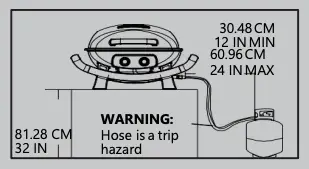 Always operate the grill on a tabletop, no higher than 81.28 cm (32 in).
Always operate the grill on a tabletop, no higher than 81.28 cm (32 in).- Place the LPG tank on the ground adjacent to the tabletop and with a minimum clearance of 30.48 cm (12 in) and no further than 60.96 cm (24 in) from the grill. Failure to follow these instructions could cause the LPG tank to overheat and vent
- LPG, which could ignite, causing serious personal injuries or property damage and/or a tripping hazard over the gas hose or LPG tank, pulling the grill off the tabletop, causing serious personal injuries or property damage.
THE FUEL SYSTEM: Gas grills are used safely by millions of people when following simple safety precautions. The items in the fuel system are designed for operation with this grill. They must not be replaced with any other brand. (See parts list for replacement items.)
GAS BURNER: The gas burner is constructed of stainless steel and should not require maintenance other than inspection for insects/nests inside the air intake slots.
LP GAS REGULATOR CAUTION: The gas pressure regulator provided with this appliance must be used. This regulator is equipped with the required orifice and is set for the required outlet pressure for this appliance. This combination of orifice size and pressure regulation specifications provides the intended cooking performance.
FUEL SUPPLY HOSE: The hose-connected regulator provided with this appliance is 91.44 cm (3 ft) length. Keep the fuel hose away from any heated surface(s).
WARNING: LPG is a flammable gas. Improper handling may result in an explosion and/or fire and serious accident or injury. Your grill is designed to operate with LPG only and is equipped with the proper orifice for LPG.
CAUTION: Do not connect this grill with any gas supply other than LPG. LPG is heavier than air and settles in lower areas. Make certain adequate ventilation is available when using your grill. The gas cylinder may be stored outside in a well-ventilated area out of the reach of children when the grill is not in use.
PARTS LIST
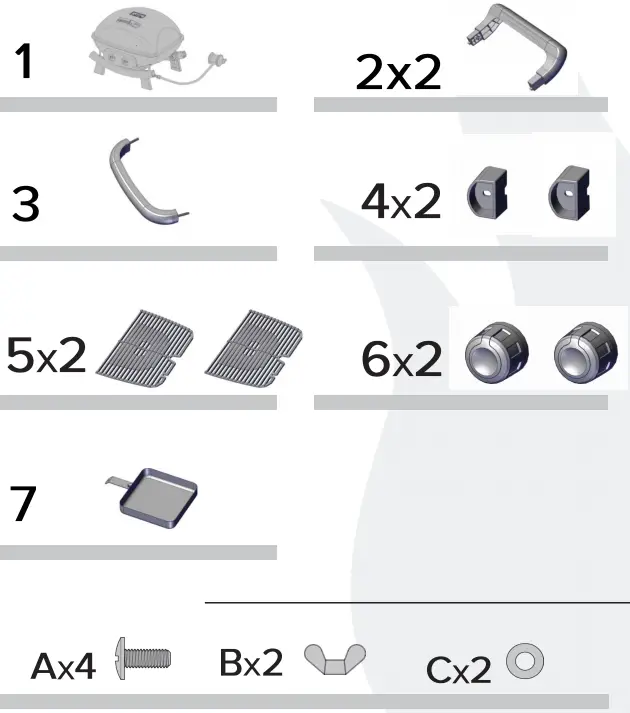

PREPARATION
Before beginning assembly, installation or operation of product, make sure all parts are present and undamaged. Compare parts with package contents list and diagram above. If any part is missing or damaged, do not attempt to assemble, install or operate the product. Contact customer service for replacement parts.
READ ALL SAFETY WARNINGS, ASSEMBLY AND INSTALLATION INSTRUCTIONS CAREFULLY BEFORE ATTEMPTING TO ASSEMBLE.
ASSEMBLY INSTRUCTIONS

QUESTIONS, PROBLEMS, MISSING PARTS? Before returning to your retailer, call our Customer Service Department at +4562206336 from 8 a.m. to 5 p.m. PST Monday-Friday. You can also reach us by email at: [email protected]

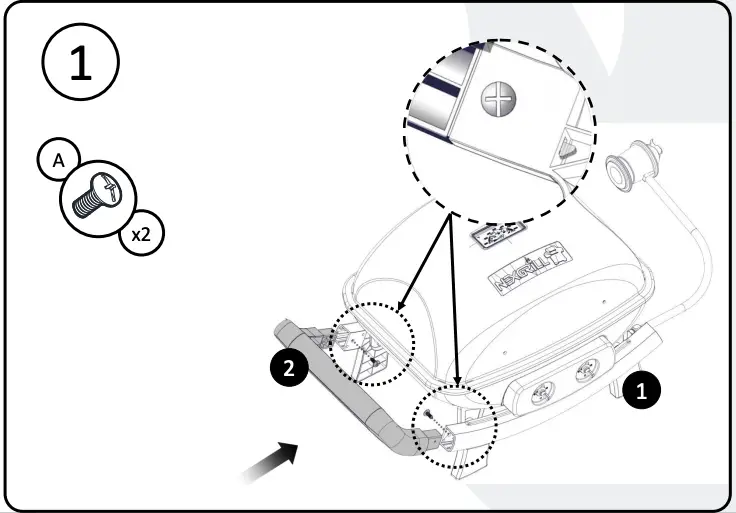
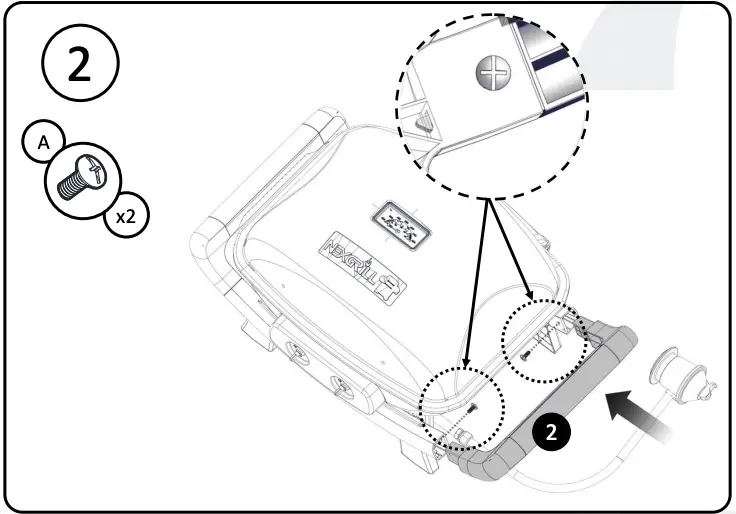
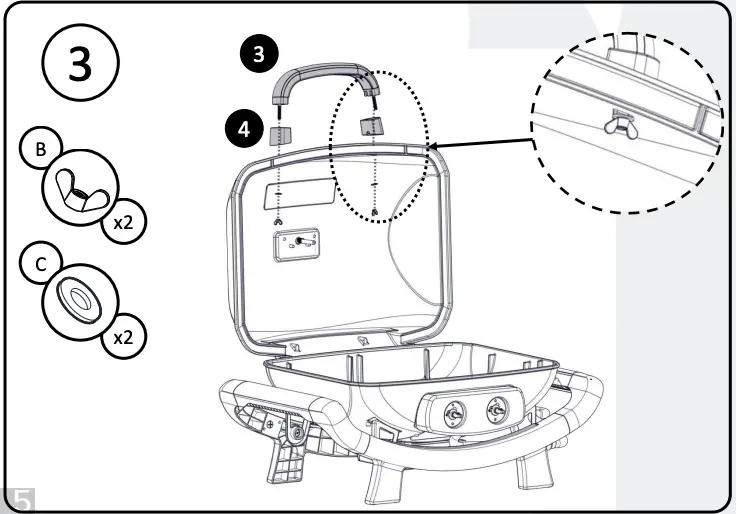
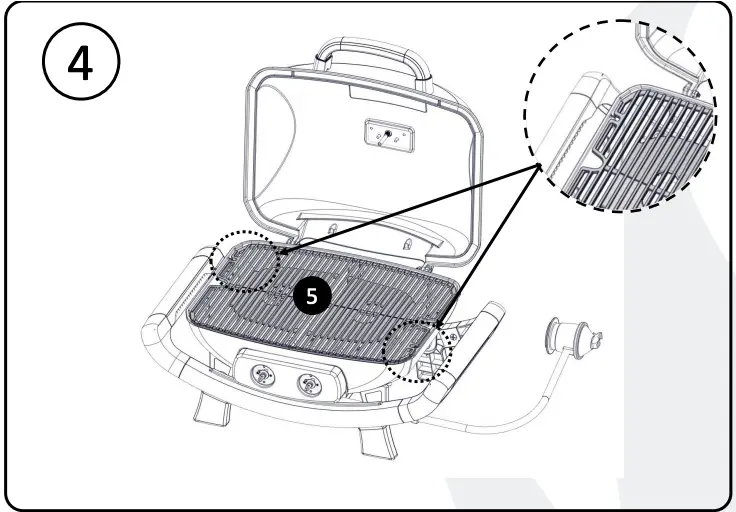
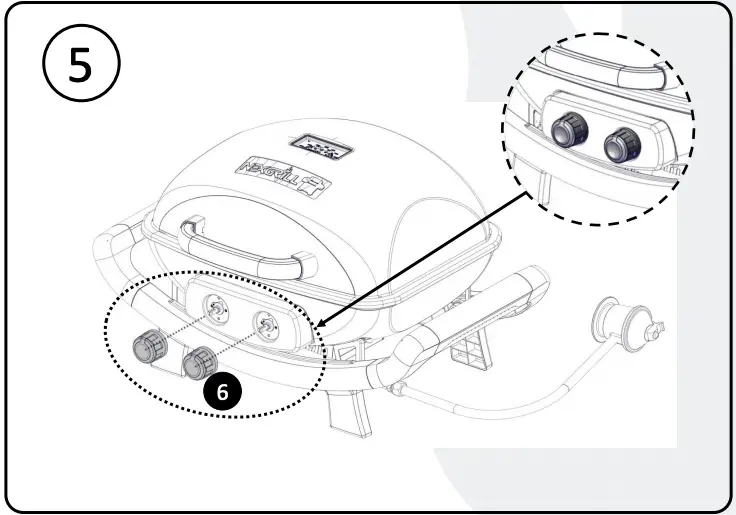
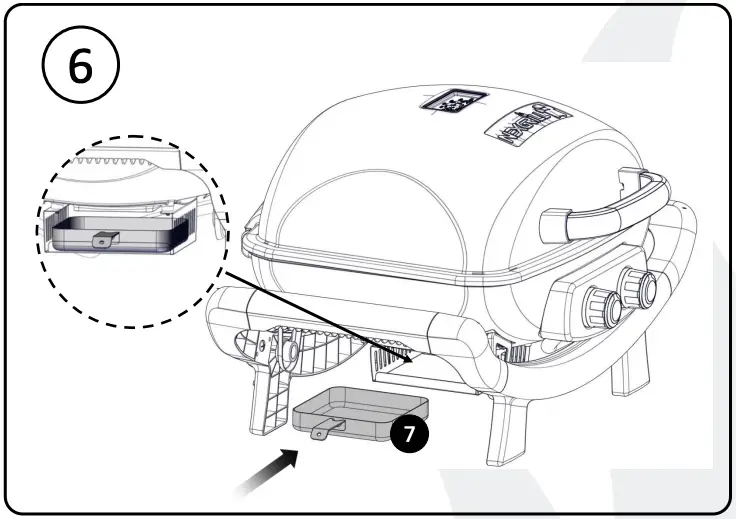
CONNECTION INSTRUCTIONS
GAS HOOK-UP
Only the pressure regulator and hose assembly supplied with the grill should be used. Any replacement pressure regulator and hose assembly must be specified by the grill manufacturer. Any replacement pressure regulator and hose assembly should comply with EN 16129:2013 and the national regulation. The flexible hose used, with a length not exceeding 1.50 meters, should comply with EN 16436-1:2014. This grill is configured for liquefied petroleum gas. Do not use a natural gas supply.
Total gas consumption (per hour) with all burners set on “HIGH”:
EACH BURNER 1.75kW.
TOTAL 3.5kW.

WARNING:
NEVER ATTEMPT TO USE DAMAGED OR OBSTRUCTED EQUIPMENT. SEE YOUR LOCAL LIQUID LPG DEALER FOR REPAIR.

WARNING:
CHECK ALL GAS SUPPLY FITTINGS FOR LEAKS BEFORE EACH USE. DO NOT USE THE GRILL UNTIL ALL CONNECTIONS HAVE BEEN CHECKED AND DO NOT LEAK. DO NOT SMOKE WHILE LEAK-TESTING. NEVER LEAK-TEST WITH AN OPEN FLAME.
GENERAL
Although gas connections on the grill are leak-tested prior to shipment, a complete leak test must be performed at the installation site. Before each use, check all gas connections for leaks using the procedures listed below. If the smell of gas is detected at any time, you should immediately check the entire system for leaks.
BEFORE TESTING
Make sure all packing materials have been removed from the grill, including the burner tie-down straps.
STEP 1
CREATE THE SOAPY WATER
Prepare a 50/50 solution of water and ammonia-free dish detergent, to be applied using a spray bottle or brush.
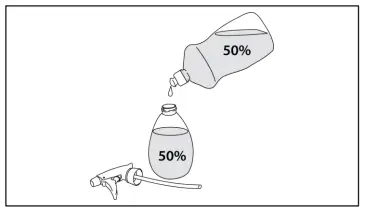
STEP 2
CONNECTING THE LIQUID LPG CYLINDER
The cylinder valve should be in the CLOSED position. If not, turn the valve clockwise until it stops.
Make sure the burner valves are in the “OFF” (O) position. Inspect the valve connections, port and regulator assembly. Remove debris and inspect the hose for damage. When connecting the regulator assembly to the valve, use your hand to tighten the nut clockwise until it stops. Use of a wrench could damage the quick-coupling nut and result in a hazardous situation.
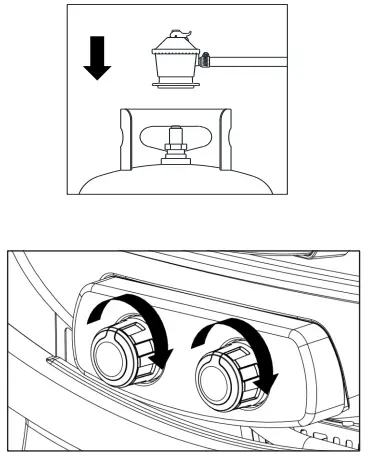
STEP 3
TO TEST
- Make sure the burner valves are closed.
- Turn the liquid LPG cylinder valve counterclockwise to open the valve.
- Apply the soap solution to all gas fittings. Soap bubbles will appear where a leak is present.
- If a leak is present, immediately turn the liquid LPG cylinder valve to the CLOSED position and tighten leaky fittings.
- Turn the liquid LPG cylinder valve back to the OPEN position and recheck.
- Should the gas continue to leak from any of the fittings, turn the liquid LPG cylinder valve to the CLOSED position and contact our Customer Service Department at +4562206336 8 a.m.-5p.m. PST Monday-Friday. Or email us at: [email protected].
- If there is evidence of excessive abrasion or wear, or the hose is cut, it must be replaced prior to the outdoor cooking gas appliance being put into operation.
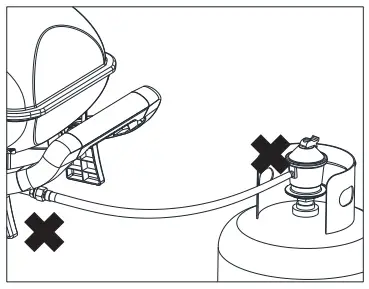

WARNING:
DO NOT STORE GRILL INDOORS UNLESS THE CYLINDER IS DISCONNECTED. DO NOT STORE CYLINDER IN A BUILDING, GARAGE, OR ANY OTHER ENCLOSED AREA, AND KEEP OUT OF REACH OF CHILDREN AT ALL TIMES.
INSTALLER FINAL CHECK
Maintain specified clearance of 91.44 cm (36 in) from combustible materials and construction.
- All internal packaging has been removed.
- The hose and regulator are properly connected to the liquid LPG cylinder.
- The unit has been tested and is free of leaks.
- The gas supply shutoff valve has been located.

WARNING:
- DO NOT STORE SPARE LIQUID LPG CYLINDERS UNDER OR NEAR THIS APPLIANCE.
- NEVER FILL THE CYLINDER BEYOND 80 PERCENT CAPACITY.
- IF THE INFORMATION IN ITEMS 1 AND 2 IS NOT FOLLOWED EXACTLY, A FIRE CAUSING DEATH OR SERIOUS INJURY MAY OCCUR.
OPERATING INSTRUCTIONS

THIS COOKING APPLIANCE IS FOR OUTDOOR USE ONLY AND SHALL NOT BE USED IN A BUILDING, GARAGE OR ANY OTHER ENCLOSED AREA.
STEP 1
FIND A LEVEL SURFACE ON WHICH TO PLACE THE GRILL
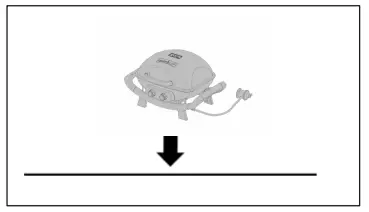

MOVING INSTRUCTIONS
Caution: Never move the grill with burners lit.
Make sure control knob is in the “OFF” (O) position. Disconnect the LPG cylinder from the regulator.
Remove the regulator from the LPG tank. Be sure the grill has completely cooled for at least 30 minutes.
Close the lid. Use the side handles to carry the grill.
NOTE: It is best to leave the grease tray in place attached to the bottom of the grill; some grease may continue to drip from drain hole during transport.
STEP 2
CONNECT TO TANK.
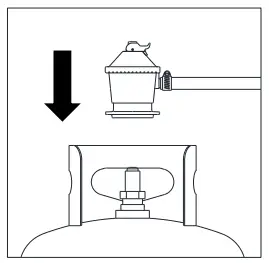

IMPORTANT – FIRST TIME USE:
It is important that the grill be lit and allowed to heat up for at least 15 minutes before any food is placed on the cooking grid. It is normal for some smoke to appear during the initial operation of the grill. After initial heating, the grill is ready for use. A cooking spray may be used on the cooking grids to allow easier clean up.
STEP 3
OPEN THE LID AND TURN KNOB TO IGNITE
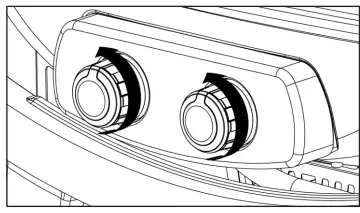

If ignition does not occur within 3-5 seconds, turn the control knob “CLOSE.” Wait 5 minutes before attempting to re-light the grill. If the grill fails to ignite after the second attempt, call our Customer Service Department at +4562206336 8 a.m.-5 p.m. PST Monday-Friday. You can also reach us by email at: [email protected] for assistance.
With burner lit, gently close the lid and allow the grill to warm up for 10-15 minutes prior to use.

- Allow the grill to warm up with the lid closed for 5 minutes prior to cooking.
- You may cook on the grill in any weather. If the temperature is extremely cold or hot, the cooking times will be slightly increased or decreased. Keep the grill out of excessive winds when operating.
- The cooking times listed below are only suggestions. Cooking times vary depending on thickness of meats and the desired degree of preparation.

Steak – (T-Bone), thick cut, medium doneness: grill 10 minutes on each side on MED setting.
Chicken – (Quarters): grill 30 minutes per side on MED setting. Check for doneness.
Pork – (Ribs/chops): grill 10-20 minutes per side on MED setting. Check for doneness.
Fish – grill 20-30 minutes on LOW setting.
Turkey – (Breast): grill 10 minutes per 0.5 kg or per pound or until internal temperature reaches 76 °C (170 °F) on MED setting.
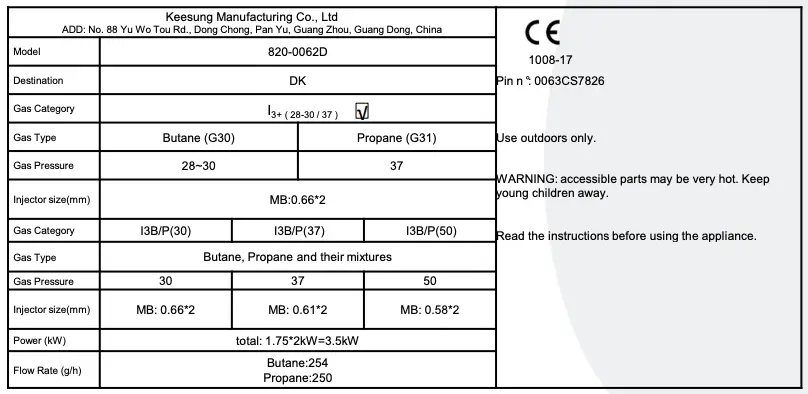
NOTE
Use 30 mbar regulator and its corresponding injector size for butane/propane under the category I3B/P(30).
Use 30 mbar regulator and its corresponding injector size for butane under the category I3+(28-30/37).
Use 37 mbar regulator and its corresponding injector size for propane under the category I3+(28-30/37).
Use 50 mbar regulator and its corresponding injector size for butane/propane under the category I3B/P(50).
Marking on the injectors indicate the injector sizes. For example, “0.66” means the injector size is 0.66 mm.
- Turn knob to “OFF” (O) position.
- Turn the LPG cylinder control knob to the CLOSED position.
CAUTION: Do not attempt to re-light the grill without following all the lighting instructions. - Allow the grill body to cool at least 30 minutes before attempting to move or transport.
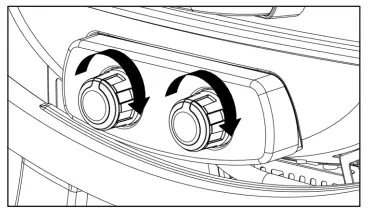
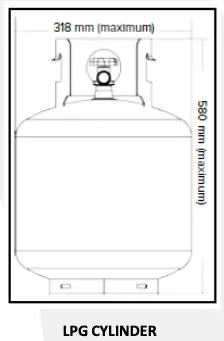 Only use cylinders with a minimum capacity of 5 kg and a maximum capacity of 15 kg. A tank of approximately 318 mm (12.5 in) in diameter by 580 mm (22.8 in) in height shall be the maximum size LPG cylinder which can be used.
Only use cylinders with a minimum capacity of 5 kg and a maximum capacity of 15 kg. A tank of approximately 318 mm (12.5 in) in diameter by 580 mm (22.8 in) in height shall be the maximum size LPG cylinder which can be used.
A dented or rusty LPG cylinder may be hazardous and should be checked by your supplier. Never use a cylinder with a damaged valve. The LPG supply cylinder to be used must be constructed and marked in accordance with the specifications for LPG cylinders that adhere to national regulations for the country of use. The gas cylinder must have a shut-off valve terminating at the valve outlet. Storage of an outdoor cooking gas appliance indoors is permissible only if the cylinder is disconnected and removed from the outdoor cooking gas appliance. The cylinder system must be arranged for vapour withdrawal. The cylinder must include a collar to protect the cylinder valve. Manifold pressure: (operating) 27.9 cm (11 in) water column, (non-operating) 28.4 cm (11.2 in) water column.
The LPG cylinder must be fitted with an overfill protection device (OPD). Remove the plastic valve cover from the LPG cylinder. Make sure the grill gas hoses do not contact the grease pan or grill firebox when the LPG cylinder is placed into the cart.
CARE AND MAINTENANCE
THERE IS VERY LITTLE CARE AND MAINTENANCE NEEDED.
The tabletop grill is designed and made of materials that will last many years with normal use. Following these instructions will improve the longevity of the grill and quality of cooking. To ensure safe operation of your grill, the area of cooking should always be kept free of combustible materials of any type, such as gasoline or other flammable vapours or liquids.
OUTSIDE GRILL PARTS – This is cast aluminum and plastic. It can be cleaned easily with warm soapy water.
COOKING GRID AND GREASE TRAY – The cooking grids are made of coated cast iron. They should be scrubbed with a grill brush immediately after cooking, while the grill is still warm. The grease tray can be cleaned easily with warm soapy water. CAUTION: The grease tray must be kept clean and free of heavy buildup for the grill to perform properly and to eliminate flare-ups.

NATURAL HAZARD • SPIDERS AND OTHER INSECTS
FACT: Sometimes spiders and other small insects climb into the burner tube. The spiders spin webs, build nests and lay eggs. The webs or nests can be very small, but they are very strong and can block the flow of gas, causing an unsafe situation. Clean burner prior to use after storing, at the beginning of grilling season or after a period of one month not being used.
WHEN TO LOOK FOR SPIDERS
You should inspect the burners at least twice a year or immediately after any of the following conditions occur:
- Gas can be smelled in conjunction with burner flames appearing yellow.
- The grill does not reach temperature.
- The grill heats unevenly.
- The burners make popping noises.
BURNERS – Extreme care should be taken when removing and replacing a burner. It must be correctly centred on the orifice before any attempt is made to relight the grill. Frequency of cleaning will depend on how often you use the grill. Failure to properly place the burner over the orifice could cause a fire to occur behind and beneath the valve panel, thereby damaging the grill and making it unsafe to operate. Before cleaning, make sure the gas supply is CLOSED and control knobs are in the CLOSED and ’’OFF” (O) position and the burners have cooled.
STEP 1
To remove the burners for cleaning:
- Locate the burner screws at the rear of the firebox.
- Remove the screws and lift the burners out of the firebox.
- Remove ignitors from burners.
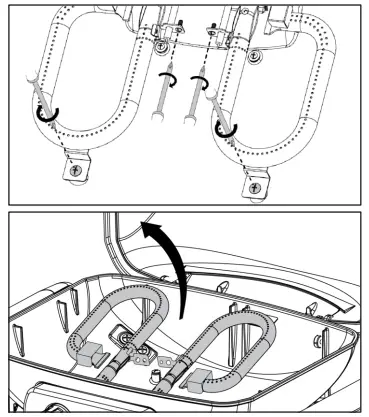
STEP 2
To clean the grill burners:
- Clean the exterior of the burner with a wire brush. Use a metal scraper for stubborn stains or debris.
- Clear clogged ports with a straightened paper clip. Never use a wooden toothpick as it may break off and clog the port.
- Check and clean burners / venturi tubes for insects and insect nests. A clogged tube can lead to a fire beneath, and behind the main control panel.
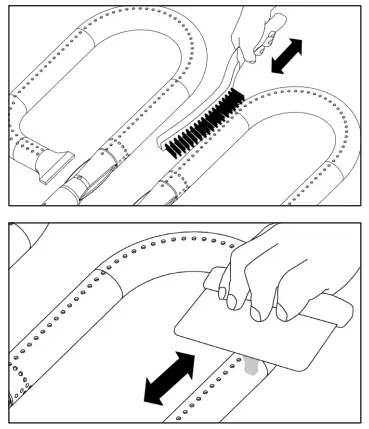
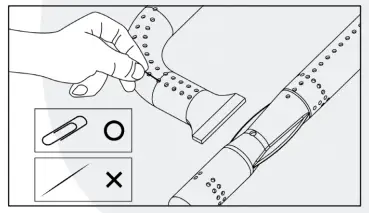
STEP 3
To reinstall the burners:
- Assemble ignitors to the burners.
- Insert the burners onto the main burner gas valves.
- Make sure the orifice tip (A) is inside the burner venturi (B).
- Align the burner screws holes with the firebox holes, insert screws and tighten.
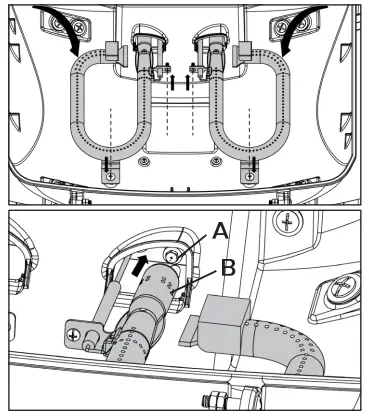
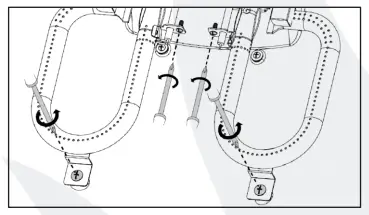
FIREBOX
Use warm soapy water to clean this area. Do not allow grease to build up.
DRAIN HOLE
The drain hole must be kept clear of grease and food particles to allow drippings to drain properly into the grease tray. This must be done to maintain proper operation of your grill.

This grill, like all equipment, will look better and last longer if kept out of the weather when not in use.

CAUTION: Do not store LPG cylinders in enclosed areas. When using a cover or moving the grill, always wait until the grill has cooled for at least 30 minutes.
- Do not obstruct the flow of combustion and ventilation air.
- A clogged tube can lead to a fire beneath the appliance.

This unit must be kept in an area free from combustible materials, gasoline and other flammable vapors and liquids. Make sure all openings into the grill body are free of blockages or debris and there are no objects or materials blocking the flow of combustion or ventilation. Make sure the legs are in the up position when using the grill. Check burner air inlet openings (behind the inlet guard on the right end of the grill body) for insect nests or blockages. Make sure the slots in the burner tube are clear.
When the grill is not in use, turn the control knobs to the “OFF” (O) position and remove the LPG cylinder from the regulator. If stored indoors, detach and leave LPG cylinder outdoors. LPG cylinders must be stored out of reach of children.
REPLACEMENT PARTS LIST

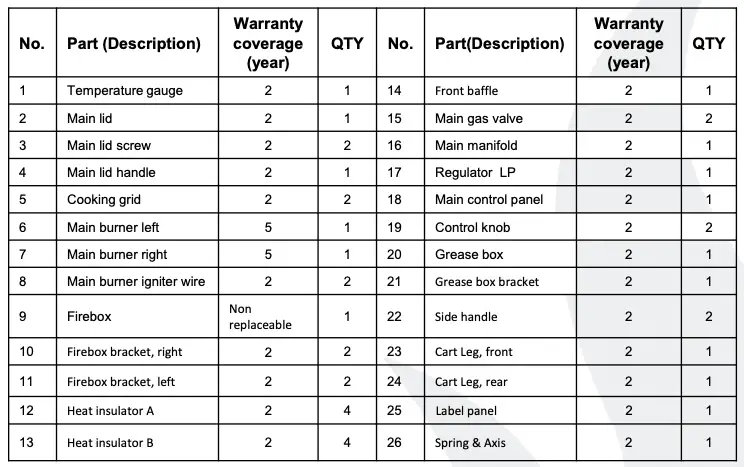
* – NO RUST-THROUGH OR BURN-THROUGH OF ALUMINUM CASTING
 – EXCLUDING FADING OR DISCOLORATION.
– EXCLUDING FADING OR DISCOLORATION.
TROUBLESHOOTING
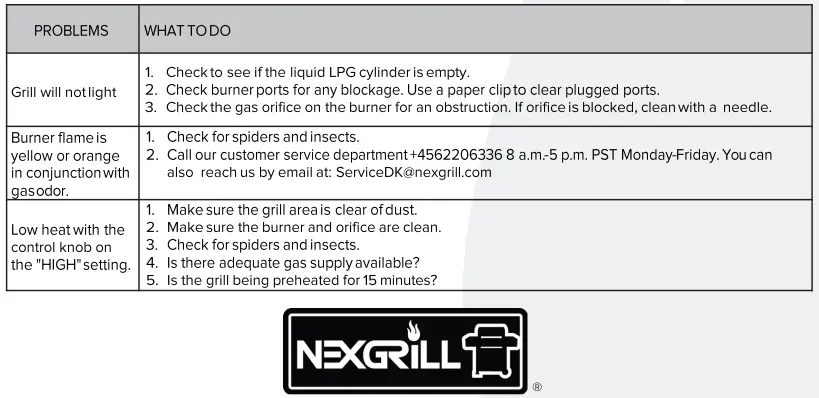
©2017 NEXGRILL INDUSTRIES, INC.
CHINO, CA. 91710
1-800-913-8999
Made In China
]]>USER MANUAL

- Safety Precautions & Warnings
- Parts List
- Assembly Instructions
- Leak Testing
- Lighting Instructions
- Troubleshooting
- General Cleaning and Maintenance
- Preparation and Cooking Instructions
- Limited Warranty
- Recipes
WARNING:
- READ ALL INSTRUCTIONS BEFORE USING THIS TURKEY FRYER. FAILURE TO FOLLOW ALL MANUFACTURER’S INSTRUCTIONS COULD RESULT IN A FIRE OR EXPLOSION WHICH COULD CAUSE PROPERTY DAMAGE, PERSONAL INJURY OR DEATH.
- USE ONLY THE ENCLOSED HOSE & REGULATOR.
- DO NOT USE THE ENCLOSED HOSE & REGULATOR ON ANY OTHER GAS APPLIANCES!!
- USE OUTDOORS ONLY!!
Model Number: 720-0076
- NEVER operate an outdoor cooker inside a building or confined area or within 10 feet of any combustible surface or material. Perform all testing outdoors in a well-ventilated area. Use cooker on level, solid ground or on a concrete surface.
- NEVER leave cooker unattended while cooking.
- NEVER place an empty pot on the burner or allow liquid to evaporate completely from the stockpot.
- NEVER fill cookware more than half way with water to prevent a boil over when food is added.
- NEVER fill the pot more than 1/3 full of cooking oil. This is to allow for displacement of oil caused by the addition of food; however, always check the oil level to ensure adequate coverage so foods will fry evenly.
- NEVER leave hot oil unattended when frying.
- Always follow leak testing procedures before lighting burner.
- Use only to adjust the flame. Use to turn the cooker ON and OFF. When finished cooking, or in case of an emergency, turn the clockwise to the “OFF” position. Be sure to close the before disconnecting the hose.
- KEEP CHILDREN AND PETS AWAY from the cooker when it is in operation and afterward while it is still hot.
- NEVER use a flame to test for leaks.
- The burner should always light within 5 seconds; if not, turn tank valve and regulator off then always wait 5 minutes for gas fumes to dissipate before repeating lighting procedure.
- Use only D.O.T. certified (US Department of Transportation) LP gas cylinders. Always close LP cylinder valve after use. Always use and store LP cylinder in a cool, well-ventilated area away from heat and flames. Carefully read and follow instructions on LP cylinder.
- The pot, including handles and lid, gets dangerously hot in use. Use well-insulated pot Holders or oven mitts when handling the pot. Safety goggles are also recommended to protect you from oil splatter. The oil remains dangerously hot hours after use.
- Maximum cooking temperature is 375°F, and maximum turkey weight is 25 pounds.
DANGER
If you smell gas:
- Shut off gas to the appliance.
- Extinguish any open flame.
- Open lid.
- If odor continues, keep away from the appliance and immediately call your gas supplier or your fire dept.
WARNING
- Do not store spare LP cylinder within 10 feet (3m) of this appliance.
- Do not store or use gasoline or other flammable liquids or vapors within 25 feet (8m) of this appliance.
- When cooking with oil/grease, do not allow the oil/grease to get hotter than 350°F (177°C.
- Do not leave oil/grease unattended.

Required Tools: adjustable wrench(not supplied); Philips or flat head screwdriver(not supplied)
Estimated Time of Assembly: 10 minutes
The hose and regulator is a pre-assembled unit. Do not take it apart. Simply connect the hose and regulator assembly to the LP gas cylinder and to the cooker. An adjustable wrench is needed when attaching the hose to the gas cooker.
1. Insert the hose with brass connector through the spring and the air shutter into the receptor hole on the burner. Turn the brass connector clockwise into the threads of the receptor and tighten with a wrench. (Figure #a)

2. Make sure the valve on the Propane Tank is clean. Connect the hose to the tank valve by turning the collar to the right. Hand tighten. (Figure #b)

Place heat shield piece between windproof circle and burner support panel. (Figure #c)
Place burner on heat shield piece. (Figure #d)
Adjust burner bolt to go through heat shield piece and burner support panel. Secure burner and heat shield piece with a screw by using a spanner(not provided). (Figure #e)

Put the safety ring on the stand. (Figure #f)
Secure the safety ring to the stand by using the 2 clamps fixed on the stand. (Figure #g)

To attach the handle to the dipping basket, align the 3 holes on handle to any 3 holes along the upper-outer rim of basket. With nuts and bolts provided, use a philips or flat head screwdriver, attach the nuts on the outside of the basket and bolts from the inside. Tighten securely and make sure handle is tight and secure. (Figure #h)

(After assembly is complete, check for gas leaks before lighting.)
FOR YOUR SAFETY
- A leak test must be repeated each time the LP tank is connected or reconnected.
- Do not smoke during leak test.
- Do not use an open flame to check for gas leaks.
- The cooker must be leak tested outdoors in a well-ventilated area, away from ignition sources such as gas fire or electrical appliances. During the leak test, keep the cooker away from open flames or sparks.
TO TEST FOR A LEAK
- Close the regulator valve. This shuts off the flow of gas from the regulator to the burner.
- Be sure regulator is tightly connected to Propane Tank.
- Open the Propane Tank valve by 1/4 turn. This allows gas into the regulator and stops it at the closed regulator valve. If you hear a rushing sound, turn the gas off immediately. There is a major leak at the connection. Correct before proceeding.
- Splash on a soapy liquid (ex. dishwashing liquid and water) on the connections around the regulator and Propane Tank connection. (Figure #i)

If “growing” bubbles appear, there is a leak. Close immediately. Retighten connections and repeat the leak test procedures. If a leak persists, Teflon tape may be needed on the threads. Teflon tape is available at any hardware store. DO NOT use the cooker if any leak cannot be stopped. Call 1-866-984-7455 for replacement of hoses.
- Always close the after performing a leak test by turning the hand wheel clockwise.
* Read instructions before lighting.
- Adjust the air shutter before you attempt to light the burner. Make sure the air shutter does not fully cover the two air holes when you try to light the burner.
- Reopen tank valve
- Have a fireplace match or long-nosed lighter lit and ready to place under the burner.
- Slowly reopen the regulator valve ¼ turn. Gas will immediately flow through the system. Light the burner from the bottom, keeping hands and face away from the top of the cooker. (Figure #j)

- After lighting the burner, open the regulator valve until a large yellow flame appears. Adjust the air shutter on the burner until the flame turns blue. Use the regulator valve to adjust the flame intensity.
- If you’ve attempted to light the burner and failed, then allow 5 minutes for any accumulated gas to dissipate before attempting to light it again.
- When finished using the cooker, turn off the gas from the tank valve first. It will take a few seconds for the fire to go out and for the propane gas to “bleed” from the hose and regulator assembly. After the fire is completely out, turn the regulator valve to the “OFF” position. After the gas is off, a small “candle” flame may appear at the orifice for about two seconds. This is normal.
Make sure the regulator fitting is screwed into the air shutter on the burner, but do not over tighten. The air shutter needs to rotate freely in order to adjust air intake.
If you have difficulty lighting this cooker, be sure to:
a. First open fully.
b. Open 1/8 – 1/4 turn and light your cooker.
c. Control flame intensity with .
d. Turn the unit “off” with the .
1. Most propane tanks are equipped with a safety device to shut off the flow of gas should the hose be cut or severed. Sometimes this safety device may be tripped when lighting the cooker. To prevent this, ALWAYS make sure the regulator valve is in the closed position ( turned fully “ clockwise”: Figure #k) before opening the tank valve.

2. To prevent tipping and the fryer oventurn, the LP gas cylinder should be placed far from the burner and reach the maximum distance as 35 inches(88.9cm). See Figure #l.

*** Before using for the first time, wash your stainless steel pot in hot, soapy water. Dry immediately to prevent water spots. To prevent scratches, avoid using sharp utensils when cooking.
*** Discoloration of the stainless steel will result if the pieces are allowed to overheat excessively. For hard-to-clean stains or discoloration of the stainless steel, use a non-abrasive stainless steel cleaner. Follow the directions on the cleaning product, using a clean, damp sponge or cloth. DO NOT scrub finish with a soap-filled steel wool pad or harsh abrasive cleanser, as scratching will occur.
- Store cooker in a cool dry place.
- Spray WD-40 on the burner grid after it has cooled to prevent rust.
- For long term storage, store the cast iron burner, the hose and regulator assembly in a plastic bag.
- Spiders and small insects have been known to spin webs inside the venturi tube of the cast iron burner. Obstructions in the venturi tube interfere with the flow of air and gas through the burner. This can cause a yellow flame or a flashback. If this happens, remove the cast burner from the frame and clean the venturi tube with a stiff, bent wire or screwdriver. We also advise cleaning inside the top ports as well.
- Do not tamper with or attempt repairs on the burner, frame, valve, or Propane Tank. Allow only qualified LP gas dealers to make repairs.
- Always close the tank valve first after use. Always use and store the Propane Tank in an upright position. Never store the Propane Tanks in occupied enclosures.
- Outdoor Use Only!! Never use inside a garage, porch, on a closed deck or near any building.
Keep the cooker away from open flames, sparks and lit cigarettes. - NEVER COVER THE POT WHEN FRYING WITH OIL. Always use a 12” Steel long stem thermometer when deep-frying. Do not exceed 375° F. Fire will occur if you exceed this temperature. Control the heat intensity with the valve on the gas cooker. If the oil begins to smoke, reduce the heat by turning valve clockwise!
- Do not touch hot surfaces. Always wear long oven mitts to protect hands and forearms when lifting the lid. Use the grab hook to lift the stockpot.
- After boiling or frying in large pots, allow the unit to set for two hours before moving. Never attempt to move the cooker when in use. Be extremely careful when moving the pot if it contains hot oil or other liquids. Always allow the cooker to cool before attempting to move or clean it.
- An approved fire extinguisher nearby is recommended – consult your local authority for recommended type and size.
- When the cooker is not in use, always disconnect the tank safety plug from the.
- After boiling seafood or peanuts, do not pour salt water onto your lawn. It will kill the grass!! Allow the water to cool and pour it down street drains.
- Do not modify or alter this cooker or its components.
Thank you for your purchase of the Nexgrill Outdoor Turkey Fryer. This product is made of rugged stainless steel so it will last for years. Your deluxe outdoor cooker will fry, steam or boil meat, seafood and vegetables. Maximum capacity is 25 pounds.
CAUTION: DO NOT use a kitchen stove for frying a turkey in this unit. This Nexgrill unit is designed for use as a outdoor cooker. Be sure to read and follow all the instructions provided with your gas cooker and propane tank.
- Included in the unit carton is a high-pressure burner, a 32 quart turkey fryer stockpot with accessories. Accessories include a perforated seafood boiler, a perforated poultry rack, a 12” long stainless steel thermometer, a grab hook and a vented lid, as well as a 10 Quart Fish Fryer Stockpot and a dipping basket.
- A long-stemmed deep fry thermometer must be used to maintain proper oil temperature at all times.
- The 32-qt turkey fryer is capable of frying a turkey up to 25 pounds.
- Peanut oil or vegetable oil may be used for frying. Peanut oil is the healthier choice for frying and also remains clear longer for reuse. For a 10-16 pound turkey use 2-1/2 – 3 gallons. ( Larger size turkeys require less oil.)
** To determine the amount of oil needed, lower the turkey into the pot and cover with water. Remove the turkey and measure the amount of water. Use the same amount of oil in place of the water when frying the turkey.
- Seasonings: salt and pepper, poultry seasoning or Cajun seasoning.
- Optional: Marinade for injecting into turkey. (Figure 1)

- Thaw the turkey completely.
- Wash the turkey and pat dry with paper towels. Remove giblets, neck, and trim away all excess fat. Make sure the opening around the neck is clear.
- Make a 1-inch cut in the skin at the leg-thigh joints. ( This will allow oil to drain when turkey is done. )
- Coat the turkey inside and out with seasonings and/or use an injectable marinade.
- Place turkey upside down on poultry rack, with legs facing up.
- Follow the the instructions to set up the burner and fryer pot.
- Place the burner and the fryer pot on a flat, level, non-combustible solid surface.
- Pour peanut oil into the pot. Use the amount determined in Step 2. Attach the thermometer to the top edge, making sure the stem of the thermometer is as far down as possible without touching the bottom of the pot.
- Light the burner as per instructions. Carefully place the pot on the cooker and then adjust the flame higher. DO NOT adjust the frame to full blast.
- Heat the peanut oil to 350°F. Measure the temperature of the oil with the deep fryer thermometer. When the oil reaches 325°F, reduce heat and allow the oil to heat gradually up to 350°F.
- Attach grab hook to the top loop of the poultry rack. Very slowly and carefully lower the turkey into pot. (Figure 2) Wear mitts for protection. Then, remove grab hook from rack. (Figure 3)
- After you lower the turkey into the hot oil the temperature will go down. Slowly increase and keep the temperature at constant 350°F. Fry the turkey about 3 to 4 minutes per pound.
- When the turkey is done, turn the cooker off at the the tank valve. Leaving the pot on the cooker, use oven mitts to hold the grab hook and lift the turkey out of the pot slowly and into another pan to drain and cool.(Figure 4) Using a meat thermometer, check the thigh joint temperature for doneness. Poultry should be at 180°F when completely cooked.
- Carefully remove the poultry rack from the turkey and place on platter……Enjoy!!

CAUTION! Use extreme care and caution when frying whole turkeys, chickens, or any other foods. Grease fires can occur. To reduce the chance of injury and/or property damage, be sure to:
- Use outdoors only! Never leave the cookers unattended!!
- Use in an open area away from any building, decks, shrubbery, or trees.
- Carefully read and follow all operation instructions provided with the gas cooker and the propane tank.
- Should a grease fire occur, turn off the gas at the tank and cover the pot with the lid.
- The poultry rack will be very hot after frying. Be careful when handling.